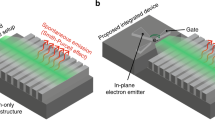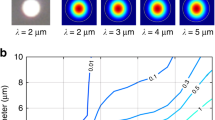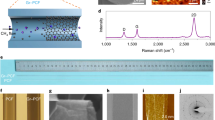Abstract
For decades now, silicon has been the workhorse of the microelectronics revolution and a key enabler of the information age. Owing to its excellent optical properties in the near- and mid-infrared, silicon is now promising to have a similar impact on photonics. The ability to incorporate both optical and electronic functionality in a single material offers the tantalizing prospect of amplifying, modulating and detecting light within a monolithic platform. However, a direct consequence of silicon’s transparency is that it cannot be used to detect light at telecommunications wavelengths. Here, we report on a laser processing technique developed for our silicon fibre technology through which we can modify the electronic band structure of the semiconductor material as it is crystallized. The unique fibre geometry in which the silicon core is confined within a silica cladding allows large anisotropic stresses to be set into the crystalline material so that the size of the bandgap can be engineered. We demonstrate extreme bandgap reductions from 1.11 eV down to 0.59 eV, enabling optical detection out to 2,100 nm.
This is a preview of subscription content, access via your institution
Access options
Subscribe to this journal
Receive 12 print issues and online access
$259.00 per year
only $21.58 per issue
Buy this article
- Purchase on Springer Link
- Instant access to full article PDF
Prices may be subject to local taxes which are calculated during checkout




Similar content being viewed by others
References
Leuthold, J. et al. Nonlinear silicon photonics. Nature Photon. 4, 535–544 (2010).
Reed, G. T. Device physics: The optical age of silicon. Nature 427, 595–596 (2004).
Lui, X. et al. Mid-infrared optical parametric amplifier using silicon nanophotonic waveguide. Nature Photon. 4, 557–560 (2010).
Luo, L. W. et al. WDM-compatible mode-division multiplexing on a silicon chip. Nature Commun. 5, 3069 (2014).
Lipson, M. Silicon photonics: An exercise in self control. Nature Photon. 1, 18–19 (2007).
Salem, R. et al. Signal regeneration using low-power four-wave mixing on silicon chip. Nature Photon. 2, 35–38 (2004).
Boyraz, O. & Jalali, B. Demonstration of a silicon Raman laser. Opt. Express 12, 5269–5273 (2004).
Rong, H. et al. A continuous-wave Raman silicon laser. Nature 433, 725–728 (2005).
Jacobsen, R. S. et al. Strained silicon as a new electro-optic material. Nature 441, 199–202 (2006).
Cazzanelli, M. et al. Second-harmonic generation in silicon waveguides strained by silicon nitride. Nature Mater. 11, 148–154 (2012).
Chmielak, B. et al. Pockels effect based fully integrated, strained silicon electro-optic modulator. Opt. Express 19, 17212–17219 (2011).
Park, H. et al. A hybrid AlGaInAs-silicon evanescent waveguide photodetector. Opt. Express 15, 6044–6052 (2007).
Michel, J. et al. High-performance Ge-on-Si photodetectors. Nature Photon. 4, 527–534 (2010).
Sazio, P. J. A. et al. Microstructured optical fibers as high-pressure microfluidic reactors. Science 311, 1583–1586 (2006).
Capasso, F. Band-gap engineering: From physics and materials to new semiconductor devices. Science 235, 172–176 (1987).
Mehta, P. et al. All-optical modulation using two-photon absorption in silicon core optical fibers. Opt. Express 19, 19078–19083 (2011).
Mehta, P. et al. Ultrafast wavelength conversion via cross-phase modulation in hydrogenated amorphous silicon optical fibers. Opt. Express 20, 26110–26116 (2012).
Ballato, J. et al. Silicon optical fibre. Opt. Express 16, 18675–18683 (2008).
Gumennik, A. et al. Silicon-in-silica spheres via axial thermal gradient in-fibre capillary instabilities. Nature Commun. 4, 2216 (2013).
Baril, N. F. et al. Confined high-pressure chemical deposition of hydrogenated amorphous silicon. J. Am. Chem. Soc 134, 19–22 (2011).
Sera, K. et al. High-performance TFT’s fabricated by XeCl excimer laser annealing of hydrogenated amorphous-silicon fabelilm. Electron Devices 36, 2868–2872 (1989).
Liu, S. D. & Lee, S. C. Large grain poly-Si (∼ 10 μm) TFTs prepared by excimer laser annealing through a thick SiON absorption layer. Electron Devices 51, 166–171 (2004).
Bulgakova, N. M. et al. Energy balance of pulsed laser ablation: Thermal model revised. Appl. Phys. A 79, 1323–1326 (2004).
Bovatsek, J. et al. Thin film removal mechanisms in ns-laser processing of photovoltaic materials. Thin Solid Films 518, 2897–2904 (2010).
Mukherjee, S. et al. Band Structure Lab. (2014); https://nanohub.org/resources/bandstrlab
Gupta, N. et al. Annealing of silicon optical fibers. J. Appl. Phys. 110, 093107 (2011).
Bianco, F. et al. Two-dimensional micro-Raman mapping of stress and strain distributions in strained silicon waveguides. Semicond. Sci. Technol. 27, 085009 (2012).
Munguia, J. et al. Strain dependence of indirect band gap for strained silicon on insulator wafers. Appl. Phys. Lett. 93, 102101 (2008).
Lagonigro, L. et al. Low loss silicon fibers for photonics applications. Appl. Phys. Lett. 96, 041105 (2010).
Orcutt, J. et al. Low-loss polysilicon waveguides fabricated in an emulated high-volume electronics process. Opt. Express 20, 7243–7254 (2012).
Masaud, T. et al. Hot-wire polysilicon waveguides with low deposition temperature. Opt. Lett. 38, 4030–4032 (2013).
Preston, K. et al. High-speed all-optical modulation using polycrystalline silicon microring resonators. Appl. Phys. Lett. 92, 151104 (2008).
Radeka, V. et al. LSST sensor requirements and characterization of the prototype LSST CCDs. J. Instrum. 4, P03002 (2006).
Lee, M, Y. et al. Deposited low temperature silicon GHz modulator. Opt. Express 21, 26688–26692 (2013).
Avrutsky, I. & Soref, R. Phase-matched sum frequency generation in strained silicon waveguides using their second-order nonlinear optical susceptibility. Opt. Express 19, 21707–21716 (2011).
Palik, E. D. Handbook of Optical Constants of Solids (Academic, 1998).
Acknowledgements
We acknowledge Diamond Light Source for time on Beamline I18 under proposal SP8211-1 and K. Ignatyev for technical assistance. We would also like to thank S. Boden for taking the helium ion microscope image, D. Tanner and S. Lei for valuable comments, S. Chaudhuri for help with the TEM work, and R. Soref for careful review and helpful discussions regarding the manuscript’s content. The authors acknowledge EPSRC (EP/J004863/1 & EP/I035307/1), NSF (DMR-1107894; primary US support) and the Penn State Materials Research Science and Engineering Center (NSF DMR-0820404) for financial support.
Author information
Authors and Affiliations
Contributions
N.H., S.M. and A.C.P. designed the research. N.H. carried out the experiments and analysed the data. P.J.A.S. and N.H. designed the electrical measurements. T.D.D., J.R.S., H.Y.C. and J.V.B. developed and fabricated the a-Si fibres. N.M.B. developed the laser heating simulations. N.H. and A.C.P. wrote the manuscript; all authors contributed to the scientific discussion and revised the manuscript.
Corresponding author
Ethics declarations
Competing interests
The authors declare no competing financial interests.
Supplementary information
Supplementary Information
Supplementary Information (PDF 2794 kb)
Rights and permissions
About this article
Cite this article
Healy, N., Mailis, S., Bulgakova, N. et al. Extreme electronic bandgap modification in laser-crystallized silicon optical fibres. Nature Mater 13, 1122–1127 (2014). https://doi.org/10.1038/nmat4098
Received:
Accepted:
Published:
Issue Date:
DOI: https://doi.org/10.1038/nmat4098
This article is cited by
-
High-quality semiconductor fibres via mechanical design
Nature (2024)
-
Flexible fibres take fabrics into the information age
Nature (2024)
-
Semiconductor core fibres: materials science in a bottle
Nature Communications (2021)
-
Recent progress of semiconductor optoelectronic fibers
Frontiers of Optoelectronics (2021)
-
Laser restructuring and photoluminescence of glass-clad GaSb/Si-core optical fibres
Nature Communications (2019)



